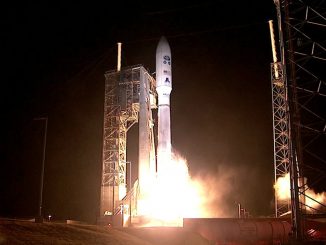
A SpaceX Falcon 9 rocket is scheduled to take off Thursday from Florida’s Space Coast with a secret cargo for the National Reconnaissance Office, which broke with standard practice to procure the launch commercially, outside of the government’s established contracting schemes.
The NRO, owner of the U.S. government’s spy satellite fleet, has not disclosed any details about the payload awaiting launch on the Falcon 9 rocket. But an NRO spokesperson confirmed the agency procured launch services for the mission, designated NROL-108, on its own, without going through the U.S. Space Force’s National Security Space Launch program.
“The NRO uses a variety of methods to procure launch services in support of the agency’s overhead reconnaissance mission, to include partnering with U.S. Space Force under the National Security Space Launch (NSSL) program,” an NRO spokesperson said in a written response to questions from Spaceflight Now.
“In some cases, the NRO uses alternative methods to procure launch services after making a cumulative assessment of satellite risk tolerance, needed launch dates, available launch capabilities, and cost — all with a purpose of ensuring satellites are safely and securely delivered to orbit in a timely manner,” the spokesperson said.
The mission is set for liftoff from pad 39A at NASA’s Kennedy Space Center during a three-hour launch window opening at 9 a.m. EST (1400 GMT) Thursday. It will be SpaceX’s second dedicated launch for the National Reconnaissance Office, following the NROL-76 mission in 2017.
In another break from normal practice, SpaceX is set to launch the NROL-108 mission without a test-firing of the Falcon 9 rocket on the launch pad. SpaceX has recently skipped the customary test-firing for launches carrying the company’s own satellites.

The launch Thursday will mark the NRO’s sixth launch of 2020, including two payloads launched on Rocket Lab’s Electron booster from New Zealand, a mission on a Northrop Grumman Minotaur 4 rocket from Virginia, and two missions on United Launch Alliance Atlas 5 and Delta 4-Heavy rockets in November and on Dec. 10.
The NRO purchased launch services from Rocket Lab through the agency’s Rapid Acquisition of a Small Rocket, or RASR, contract aimed at quickly procuring rides for small NRO missions on new light-class commercial launchers. The Minotaur 4 mission was arranged through the military’s Orbital/Suborbital Program-3 procurement vehicle, and the ULA flights for the NRO were part of the Space Force’s NSSL program.
The National Security Space Launch program is used for the government’s most critical military and intelligence-gathering satellites.
The NRO booked SpaceX for the NROL-108 launch on a commercial basis, reserving the flight on SpaceX’s manifest similar to the way a private satellite operator would purchase a ride. That usually costs less than a U.S. government launch contract, which comes with extra oversight and other additional costs.
SpaceX’s previous dedicated NRO mission — NROL-76 in 2017 — was also part of a commercial launch service arranged between the spy satellite agency and Ball Aerospace, a satellite manufacturer based in Boulder, Colorado. Ball Aerospace booked the launch with SpaceX on behalf of the NRO, and handed over the classified payload to the NRO after it was safely in orbit.
“NROL-108 carries a national security payload designed, built and operated by the National Reconnaissance Office,” the NRO spokesperson said. “Additional details about the payload and its mission are protected. The name or names of the contractor or contractors associated with building this payload is/are also protected.”
The NROL-108 mission did not appear on any public launch schedules until early October, when Spaceflight Now was first to report the existence of the mission. At that time, the mission was scheduled for Oct. 25, but the flight was delayed several times amid changing SpaceX launch schedules and other NRO launch activity at Cape Canaveral.

The commercial nature of the NRO’s launch contract with SpaceX gives the Federal Aviation Administration regulatory oversight over the mission, just as if the Falcon 9 was launching a privately-owned payload.
The launch will mark the 38th FAA-licensed commercial space launch of the year by a U.S. company, exceeding the previous mark of 33 such missions in 2018.
It’s also SpaceX’s 26th and final planned launch of 2020, besting the company’s record of 21 missions in 2018.
“The future for this industry is no longer conjecture, prognostication and wishful thinking,” said Wayne Monteith, the FAA’s associate administrator for space transportation. “It is demonstrated an accelerated growth. It is an increase in cadence on steroids.”
“We’ve launched more commercial space launches in just the last four years than we did in the previous 15 years combined,” Monteith said Tuesday in virtual presentation at the Space Foundation’s Space Symposium 365 forum. “In 2011, we only had a single commercial space launch.”
“Next year, we should easily surpass 50 commercial launches, and potentially over 100 shortly thereafter,” Monteith said. “We see mega-constellations going up, and we see the beginnings of an exceptionally robust space tourism sector. We see initiatives for commercial off-world efforts. We see commercial companies who can return material from space.”
Monteith, a retired Air Force general, said government agencies can save money by buying a space launch service on a commercial basis.
“I believe that the NRO now clearly sees that with utilizing (commercial launches), where it makes sense, because not only does it offload resource requirements from a personnel perspective for them, but also cost,” Monteith said. “By going to the commercial market, you essentially can leverage economies of scale and potentially get a lower cost to orbit, and therefore, if you save your money there, you can roll that money into your science portion, which is your payload. With NASA, we’re seeing the same thing.”
“The SpaceX launch on Thursday, that we have licensed, is carrying an NRO payload,” Monteith said. “So we’re seeing this. It makes intuitive sense, which is not always associated when you talk about the United States government.”
Airspace warning notices associated with the NROL-108 launch suggest the Falcon 9 rocket will fly northeast from the Florida coast. The rocket’s reusable first stage booster will shut down its nine kerosene-fueled Merlin engines and separate at T+plus 2 minutes, 18 seconds, then use cold gas control thrusters to flip around and begin heading back to Cape Canaveral.
A boost-back burn using some of the rocket’s Merlin engines will start guiding the booster back to Florida’s Space Coast, followed by an entry burn and a final landing burn using the first stage’s center engine.
Touchdown on Landing Zone 1 at Cape Canaveral Space Force Station is scheduled at T+plus 8 minutes, 15 seconds.
A mission timeline published by SpaceX shows the Falcon 9’s second stage will ignite its single Merlin engine at T+plus 2 minutes, 30 seconds, followed by jettison of the rocket’s clamshell like payload shroud at T+plus 2 minutes, 41 seconds. The nose shroud will fall away once the Falcon 9 reaches space, revealing the mission’s classified cargo after climbing above the dense, lower layers of the atmosphere.
At the request of the NRO, SpaceX’s webcast of Thursday’s mission is expected to end coverage of the second stage’s climb into orbit with the spy agency’s top secret payload soon after payload fairing separation. The company’s live video stream will continue tracking the booster’s return to Cape Canaveral.
The Falcon 9 booster set to launch Thursday — number B1059 — has completed four trips to space and back on two Dragon cargo flights to the International Space Station, a mission launching satellites for SpaceX’s Starlink internet network, and the launch of Argentina’s SAOCOM 1B Earth observation satellite in August.
Purpose of NROL-108 remains a mystery
Marco Langbroek, a Dutch archaeologist and an expert in satellite movements, said information gleaned from airspace warnings about the orbit targeted by the NROL-108 mission reveal few insights about the payload’s likely purpose.
The launch track toward the northeast and the location of the Falcon 9’s upper stage re-entry over the Pacific Ocean suggest the mission will place its cargo into an orbit inclined around 52 degrees to the equator, according to Langbroek.
The Falcon 9 will reserve enough propellant in its first stage to return to a landing at Cape Canaveral, rather than aiming for an offshore landing on a SpaceX droneship. That indicates the mission is likely aiming for a relatively low orbit a few hundred miles above Earth, Langbroek wrote on his website, similar but not identical to the orbit of the NROL-76 mission in 2017.
The expected orbit for the NROL-108 mission does not match the NRO’s known fleet of optical, radar, and signals intelligence satellites, expert analysts said.
A group of hobbyist satellite trackers will attempt to locate the NROL-108 payload after launch. The military does not release orbital data on U.S. national security satellites.
“It will be interesting to see in which orbit NROL-108 will end up,” Langbroek wrote. “As I have remarked with some launches earlier this year, the latest NRO launches all seem to be ‘new’ kinds of payloads that are likely experimental/mission demonstrators, and which go into ‘new’ kinds of orbits.”
“The character of the mission is a mystery: this looks to be something new again,” he wrote.
New blogpost:
“NROL-108: another mystery launch perhaps similar to NROL-76 (USA 276)?”https://t.co/yznJKJLuVr@SSC_NL pic.twitter.com/EQHZM26ykQ— Dr Marco Langbroek (@Marco_Langbroek) December 15, 2020
Ted Molczan, a Canadian satellite observer, said Langbroek’s orbit estimate suggests the NROL-108 payload will repeat ground coverage every three days or so.
“Ground tracks that repeat at intervals two to four days are a common feature of NRO satellites,” Molczan told Spaceflight Now. “They enable rapid revisit of targets, which is useful for reconnaissance.
Molczan cautioned that although observers and analysts can deduce information about NRO satellites through orbital information, optical characteristics, and radio transmissions, the exact mission may remain secret
“Though much can be deduced through analysis of orbits, optical characteristics, and radio transmissions, the exact mission may remain secret until someone with insider knowledge leaks it to the news media,” Molczan said.
Email the author.
Follow Stephen Clark on Twitter: @StephenClark1.



